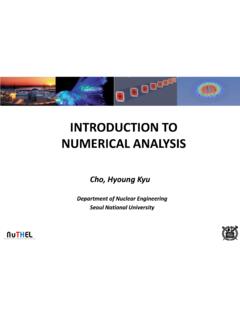Transcription of INTRODUCTION TO NUMERICAL ANALYSIS
1 Cho, Hyoung KyuDepartment of Nuclear EngineeringSeoul National UniversityCho, Hyoung KyuDepartment of Nuclear EngineeringSeoul National UniversityINTRODUCTION TO NUMERICAL ANALYSIS8. NUMERICAL Finite Difference Approximation of the Finite Difference Formulas using Taylor Series Finite Difference Formulas of First Finite Difference Formulas for the Second Summary of Finite Difference Formulas for NUMERICAL Differentiation Formulas using Lagrange Differentiation using Curve Use of MATLAB Built In Functions for NUMERICAL Richardson's Error in NUMERICAL NUMERICAL Partial Finite Difference Approximation of the Finite Difference Formulas using Taylor Series Summary of Finite Difference Formulas for NUMERICAL Differentiation Formulas using Lagrange Differentiation
2 using Curve Use of MATLAB Built In Functions for NUMERICAL Richardson's Error in NUMERICAL NUMERICAL Partial Background The need for NUMERICAL differentiation The function to be differentiated can be given as an analytical expression or as a set of discrete points (tabulated data). When the function is given as a simple mathematical expression, the derivative can be determined analytically. When analytical differentiation of the expression is difficult or not possible, NUMERICAL differentiation has to be used. When the function is specified as a set of discrete points, differentiation is done by using a NUMERICAL method.
3 NUMERICAL differentiation also plays an important role in some of the NUMERICAL methods used for solving differential Background Approaches to NUMERICAL differentiation Finite difference approximation Derivative at a point based on the value of points in the neighborhood of Approximate analytical expression Analytical expression that can be easily differentiated Derived by using curve fitting Derivative at a point analytical Background Noise and scatter in the data points Scatter in data Experimental error, uncertainties in the measurement (electrical noise) Simplest form of finite difference approximation Large variations !
4 better results with higher order formulas of finite difference approximation Ex) four, five and seven point finite difference formulas curve fitting can smooth out the data before the Finite Difference Approximation of the Derivative The derivative of a function at Various finite difference formulas Forward difference Backward difference Central differenceEstimated derivative: value of the slope of the line that connects the two Finite Difference Approximation of the Derivative Finite difference approximation of Finite Difference Approximation of the Derivative Example 8 1: Comparing NUMERICAL and analytical Finite Difference Approximation of the Derivative Example 8 1: Comparing NUMERICAL and analytical differentiationCentral difference formula gives a more accurate approximation!
5 Smaller separation between the points gives a significantly more accurate approximation! Finite Difference Approximation of the Derivative Example 8 2: Damped vibrations A block of mass Attached to a spring ( ) and a dashpot ( ) Data record for the block position: 5 Hz(a)Calculate velocity at time 5 and 6 (b)Write a user defined MATLAB function that calculates the velocity: dx=derivative(x,y)first point: forward difference , last point: backward differenceall the other: central differenceRecorded data for the first 10 Finite Difference Approximation of the Derivative Example 8 2: Damped vibrations(a)Calculate velocity at time 5 and 6 (b)Write a user defined MATLAB function that calculates the velocityfunctiondx = derivative(x,y)n = length(x);dx(1)=(y(2)-y(1))/(x(2)-x(1)); fori=2:n-1dx(i)=(y(i+1)-y(i-1))/(x(i+1)- x(i-1));enddx(n)=(y(n)-y(n-1))/(x(n)-x(n -1)); Finite Difference Approximation of the Derivative Example 8 2: Damped vibrations(b)Write a user defined MATLAB function that calculates the velocity.
6 (c)Make a plot of the displacement, velocity, and acceleration, versus time for 4 8 clear allt = 4 :8;x = [ .. ];vel = derivative(t,x)acc = derivative(t,vel);subplot (3,1,1)plot(t,x)subplot (3,1,2)plot(t,vel)subplot (3,1,3)plot(t,acc) Finite Difference Formulas using Taylor Series Expansion using Taylor series expansion for approximating derivatives Many finite difference formulas can be derived by using Taylor series expansion. It also provides an estimate for the truncation error. First derivative Second derivative Finite difference formulas of first derivative For the case where the points are equally spaced Two point forward difference formula for first derivative : approximated by a Taylor series, Remainder theorem !
7 Finite Difference Formulas using Taylor Series Expansion Finite difference formulas of first derivative Two point forward difference formula for first derivative Truncation error The magnitude of the truncation error is not really Finite Difference Formulas using Taylor Series Expansion Finite difference formulas of first derivative Two point backward difference formula for first derivative : approximated by a Taylor series, Finite Difference Formulas using Taylor Series Expansion Finite difference formulas of first derivative Two point central difference formula for first derivative (for equal spacing) Second order accuracy !
8 More accurate than the forward and backward Finite Difference Formulas using Taylor Series Expansion Finite difference formulas of first derivative Three point forward/backward difference formula for first derivative (for equal spacing) Central difference: second order accurate, but useful only for interior points Three point forward difference , , with uniform space ( )Second order accuracy ! Finite Difference Formulas using Taylor Series Expansion Finite difference formulas of first derivative Three point backward difference , , with uniform space ( )Second order accuracy !
9 Finite Difference Formulas using Taylor Series Expansion Example 8 3: Comparing NUMERICAL and analytical differentiationEx : Finite Difference Formulas using Taylor Series Expansion Finite Difference Formulas for the Second Derivative Central difference One sided forward difference One sided backward difference Three point central difference formula for the second derivative Second order truncation Finite Difference Formulas using Taylor Series Expansion Finite Difference Formulas for the Second Derivative Five point central difference formula for the second derivative 4thorder accurate Three point forward difference formula for the second Finite Difference Formulas using Taylor Series Expansion Finite Difference
10 Formulas for the Second Derivative Three point backward difference formula for the second derivative 3'''2'''23'''2'''12!3)(2!2)(2)()()(!3)(! 2)()()()(hfhxfhxfxfxfhfhxfhxfxfxfiiiiiii iii Finite Difference Formulas using Taylor Series Expansion Example 8 4: Comparing NUMERICAL and analytical differentiation(a)(b) Summary of FD Formulas for NUMERICAL Summary of FD Formulas for NUMERICAL Summary of FD Formulas for NUMERICAL Summary of FD Formulas for NUMERICAL Differentiation Formulas using Lagrange Polynomials Lagrange polynomials First derivative Two point central, three point forward, three point backward difference formulas 2 2 2 Differentiation Formulas using Lagrange Polynomials Lagrange polynomials First derivative Two point central, three point forward.




